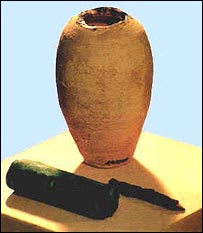The so called ‘Baghdad batteries’ are clay vases, or jars, inside of which is a copper cylinder and inside the cylinder is an iron bar protruding a stopper made of asphalt. They are just 5 inches tall (13cm). Apparently such a vessel showed signs of corrosion, and early tests revealed that an acidic agent, such as vinegar or wine had been present.
 It turns out that nobody really knows for sure what their purpose was or even their exact age. Accounts about these batteries are in fact varied and inconclusive. Some has said they are from about 250 BC – 225 AD, a period known as Parthian era. Others have commented, for example, how the artistic nature of the pots suggests they are from a different and younger era altogether, the work of the Sassanian People, who lived from 250 AD – 650 AD. Never the less, this would still be an impressive age in the past at which to be designing batteries.
It turns out that nobody really knows for sure what their purpose was or even their exact age. Accounts about these batteries are in fact varied and inconclusive. Some has said they are from about 250 BC – 225 AD, a period known as Parthian era. Others have commented, for example, how the artistic nature of the pots suggests they are from a different and younger era altogether, the work of the Sassanian People, who lived from 250 AD – 650 AD. Never the less, this would still be an impressive age in the past at which to be designing batteries.
It was Wilhelm Konig, a German archeologist and director of the Baghdad museum, who originally put forward the idea that they were batteries in 1938. It has been thought they may have been used for electroplating.
Replicas have been produced and experiments have found that a voltage from 0.8 to nearly two volts can be produced. There are accounts also of Dr Arne Eggebrecht in the late seventies connecting several replicas of the ‘batteries’ together using grape juice as an electrolyte and he claimed to have deposited a thin layer of silver on to another surface, just one ten thousandth of a millimetre thick. Other researchers dispute theses findings on account of a lack of documentation that ought to have accompanied these experiments but which hasn’t been produced. There are no photographs either to provide evidence of the work. Anyhow, it is not so much the voltage as the current produced that is the important, limiting factor in the process and it is doubted that even several these batteries together could have produced the power necessary. It has also been pointed out for comparison that merely sticking a probe into a lemon provides a greater electrical current than one of these clay vases, and that would be a much cheaper method to achieve a result.
So what was there purpose and how might they have worked, if at all?
Perhaps they were pots containing scrolls?
See further comment here: Baghdad Vases were Batteries? and The Baghdad Vases, Batteries or Scroll Pots?